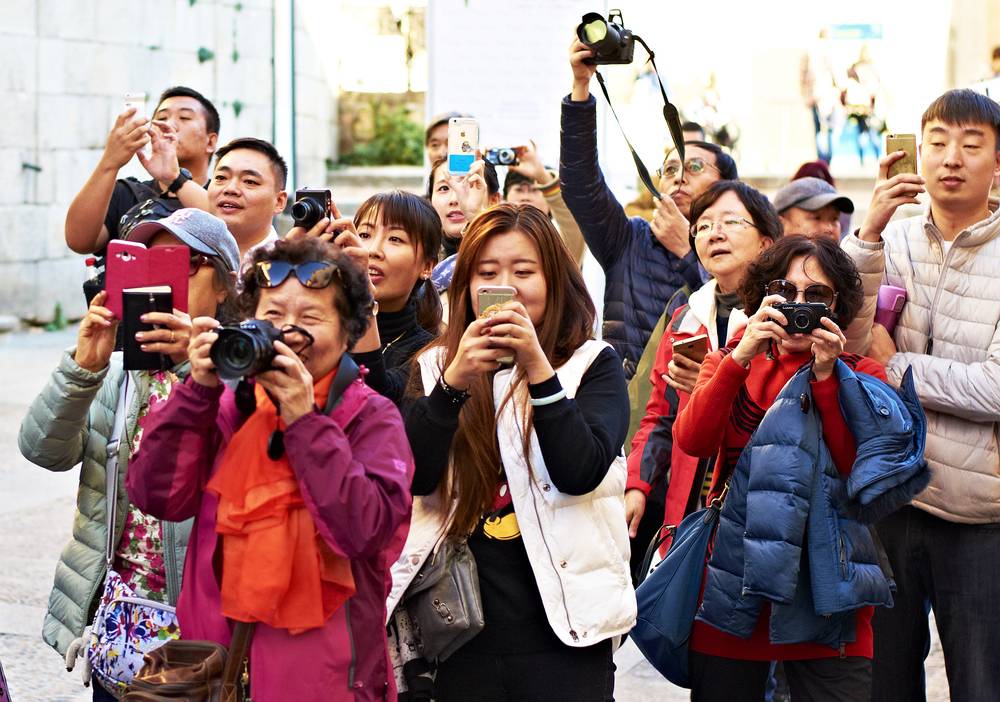


Photo credit: Shutterstock
Chinese travelers hit the road en masse over the Labor Day holidays, crowding into tourism hotspots and clogging airports.
One couple in their early thirties from China’s southwestern Sichuan Province toured around cities in the Greater Bay Area by plane and bus. The pair made a pitstop in Hong Kong to buy a Louis Vuitton bag, a big-ticket purchase they had put on hold during the pandemic.
“Hong Kong has the latest editions, and the quality of bags purchased here is guaranteed,” Mrs. Lu told Alizila.
Lu, a mainland university lecturer, and her husband also managed to squeeze in stopovers in Macau, Shenzhen and Zhuhai during their busy holiday schedule.
Holidaymakers broadly sought to pack in as much sightseeing as possible at multiple destinations after nearly three years of limited movement during the pandemic. Chinese bloggers dubbed their frantic pace of adventuring as “traveling like a special-forces soldier”.
Over five days in late April and early May, Chinese tourists made around 274 million domestic trips, according to government data, a 70.8% jump from last year’s Labor Day holidays when China was still fighting the pandemic and rolling lockdowns brought travel to a standstill, according to China’s Ministry of Culture and Tourism, and a 19% rise from the same period in 2019 before the pandemic.
“Chinese love to travel,” said Ada Xu, an executive at Alibaba Group’s online travel platform Fliggy.
Tourism Barometer
China was the world’s largest source of outbound tourists before the pandemic, and when Beijing reopened borders on Jan. 8 it unleashed its citizens’ desire for international travel.
The tourism industry has eagerly anticipated Labor Day’s statistics as an indicator of Chinese citizens’ desire to travel and spend. The holiday was the first extended public holiday since China’s reopening without pandemic-related restrictions.
Travelers during the Chinese New Year holidays still had to submit to COVID tests and confidence remained bruised from the lockdowns.
But that looks to be changing.
One visitor to Foshan City in China’s Guangdong Province on a very sunny Saturday during the Labor Day holiday reported a queue of around 200 meters to enter a local museum on martial art Kung Fu, only roughly a quarter of them were wearing masks.
Tourism spending also picked up from last year. This year’s visitors generated revenue of around RMB148 billion ($21.4 billion), up 128.9% year-on-year, the ministry said.
Commerce giant Alibaba’s annual celebration of Chinese creativity and enterprise, the Taobao Maker Festival, coincided with the Labor Day public holidays. On the first day, 1 million people thronged through the gates of the exhibitions to visit merchants in Hangzhou, Shenzhen and Chongqing.



Long-Haul Catching Up
Overseas flights are picking up steadily too. Fliggy’s data showed that outbound travel bookings over the Labor Day holidays were up over 200% compared with bookings for the Chinese New Year holiday earlier this year.
Still, long-haul travel is lagging behind this domestic tourism boom. Airlines carried only 2.24 million international passengers in the first three months of the year, 12% of 2019’s level, according to analysis by credit rating agency Fitch Ratings.
For Fliggy’s Xu, there is a simple reason why tourists have yet to return at scale to the world’s travel hotspots: it will take time to restore planes on runways.
“Transportation is the base of everything,” said Xu, the Regional Director for Europe, the Middle East and Africa at Fliggy.
“We may hope that starting from summer, the recovery will accelerate,” she said.
Airlines have been gradually reinstating flights to and from China since the reopening of the country’s borders, but there is still some way to go.
In 2019, Chinese travelers set off on a record-high 74.3 million trips abroad by air, according to data from China’s Civil Aviation Administration. In 2022, that slumped to 1.9 million.
Before the pandemic, for example, there were 32 return flights a week connecting France and China, but that number fell to just two as COVID-19 spread.
“To reach [the] same numbers of Chinese tourist[s] of 2019, we need the same number of airplanes,” Paris-based Xu explained.
As flights resume, international tourist arrivals could reach 80% to 95% of pre-pandemic levels this year depending on factors such as ticket prices, according to the United Nations’ World Tourism Organization.
Long-distance domestic travel bookings on Fliggy were up 500% year-on-year during the Lunar New Year holidays in January, and in late April, travel reservations on the platform for the May long weekend topped pre-pandemic levels.
Internationally, destinations closer to China will likely see a faster return of flight capacity and visitors.
During the Labor Day holidays, popular destinations for Chinese tourists on Fliggy included Hong Kong; Thailand; Japan; Malaysia; South Korea; Macau, China; Singapore; Vietnam; Indonesia; and Australia.
Egypt, the United Arab Emirates, Italy, Vietnam, and France also experienced rapid growth.


Pent-up Demand
While airlines work on fully restoring flight capacity, Fliggy’s Xu urged tourist destinations to prepare for the arrival of more digitally savvy Chinese tourists than pre-pandemic, who expect entertainment to mesh seamlessly with online services.
For the past three years, Fliggy has sought to maintain the link between Chinese people and European tourist attractions using technology, said Xu.
One of the company’s more eye-catching initiatives across Europe was transporting millions of Chinese consumers through livestreams to famous museums, including the British Museum, Spain’s Prado Museum, and France’s Palace of Versailles and the Louvre.
As transportation snarls unwind, Chinese tourists are raring to go.
“More than half of Fliggy’s users were born in or after the 1990s. They are affluent and more likely to travel overseas,” said Xu. “We see opportunities in working with our global partners bringing these audiences to international destinations.”
Retailers and hospitality operators worldwide are eagerly awaiting their return as a cost-of-living crisis has reined in consumer spending within their own markets.
Through the Fliggy Buy service, Chinese consumers are getting a head start on their international shopping. The tool allows users to research duty-free shops and international retailers before reaching their destination, making it easy to compile shopping lists.
After three years of isolation, these lists are getting long.
Chinese consumers have accumulated trillions of renminbi in excess savings, some of which will go towards travel and overseas shopping. In 2022 alone, new household deposits soared by RMB 17.84 trillion ($2.57 trillion), according to central bank data.
Europe’s retail and hospitality sectors stand to benefit from that pent-up demand as flight capacity ramps up over the coming months.
China’s borders are open, and its citizens are ready to begin exploring the world once more.
All they need now are the planes.
Read more Chinese tourism insights here





